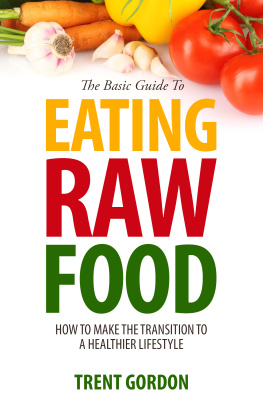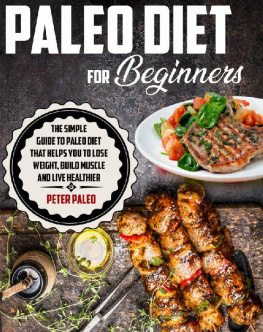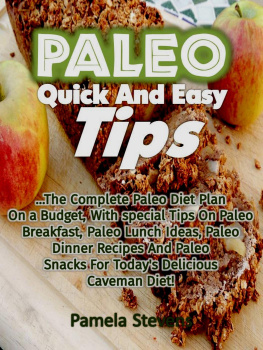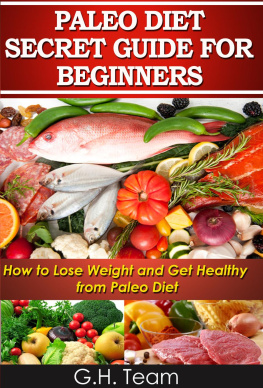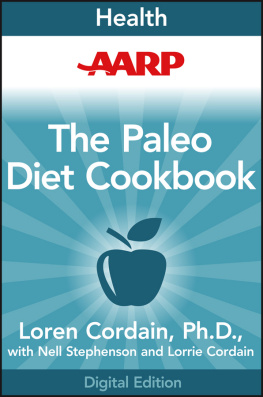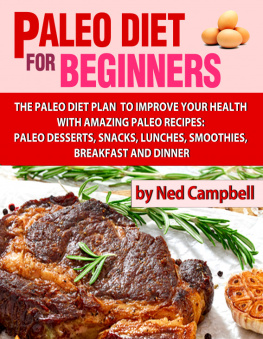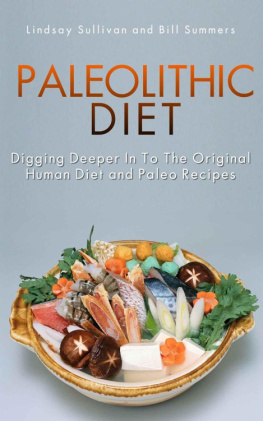Why the Paleolithic Diet Works
The Best Way to Get Healthy On a Budget
By: Trent Gordon
TABLE OF CONTENTS
PUBLISHERS NOTES
Disclaimer
This publication is intended to provide helpful and informative material. It is not intended to diagnose, treat, cure, or prevent any health problem or condition, nor is intended to replace the advice of a physician. No action should be taken solely on the contents of this book. Always consult your physician or qualified health-care professional on any matters regarding your health and before adopting any suggestions in this book or drawing inferences from it.
The author and publisher specifically disclaim all responsibility for any liability, loss or risk, personal or otherwise, which is incurred as a consequence, directly or indirectly, from the use or application of any contents of this book.
Any and all product names referenced within this book are the trademarks of their respective owners. None of these owners have sponsored, authorized, endorsed, or approved this book.
Always read all information provided by the manufacturers product labels before using their products. The author and publisher are not responsible for claims made by manufacturers.
2013
Manufactured in the United States of America
DEDICATION
This book is dedicated to my loving wife. She has always supported me when others have not.
CHAPTER 1- WHAT IS THE PALEO DIET?
If you were told that it was possible have a muscular body like Matthew McConaughey, or beautiful, lean curves like Jessica Biel or Miley Cyrus, would you believe it? How do these modern day celebrities keep fit, stay healthy, and have the glow to their skin, unending energy reserves, and beautiful, healthy bodies? Just how do they do it without starving themselves to death?
The answer is simple. They eat like cavemen. This is the basis of the Paleo Diet, which has also been called the Stone-Age Diet, or the Hunter-Gatherer Diet, which is to only eat foods that our ancestors were biologically created to eat. The foods that they ate helped to keep them from getting hungry, keep their weight under control, build muscles, and keep in shape for all of the activity they were expected to do in order to survive.
Medical research has determined that the foods we eat today are full of trans fats, sugar, and processed foods that are the causes for debilitating or life-threatening diseases. If you would like to feel better, have more energy, would love to be pleased with the way your body looks, then the Paleo Diet could be a solution for you.
The Transformation
The average caveman/cavewoman was athletic, muscular, and needed strength and endurance to accomplish the physical activities required of a hunter. The average person today has excess weight, barely gets enough exercise, deals with stress, and is suffering from serious health issues. How the Homo sapiens transformed from the epitome perfect health to those that are sluggish and basically unhealthy is blamed on the overuse of grains in the contemporary diet - such as breads, corn, rice, and pasta instead of vegetables, meat, and fruit.
Calories from vegetables and fruits are better for your body than calories from sugar or carbs, and your body reacts to these calories in different ways. When most of our calories come from carbs, the body burns those for energy. In the absence of excess carbs, the body goes through a chemical process called ketosis, in which the body burns stored fat as energy, resulting in weight loss.
What Not To Eat
OK, so how did the cavemen eat? They did not have the convenience of going to the grocery store and picking out prepared foods to grill over the open fire. As hunters and gatherers, many times they would eat what they could find, such as leafy greens, vegetables, seeds, or berries and other fruit, or they would eat the animals that they hunted down, especially wild game and fish. The Paleo diet restricts the following foods:
Sugar (unless it is consumed through fruit)
Grains
Processed foods
Dairy products
Saturated fats
What to Eat
Studies have shown that by eliminating these foods, certain diseases can be controlled, blood pressure lowered, tumors reduced, and weight lost. The following foods are allowed:
Meat (Grass-fed beef, pork)
Poultry (Chicken, turkey, duck, and other winged fowl)
Fish (No farmed fish, only wild-caught)
Eggs (Omega-3 enriched)
Non-starchy vegetables (unlimited broccoli, cauliflower, tomatoes, asparagus, etc.)
Complex carbs (Sweet potatoes, beets)
Fruit (Berries, melons, apples, peaches, apples, etc.)
Oils (Olive, avocado, coconut oils)
Nuts (Almonds, walnuts, but not peanuts)
Milk: (Almond or coconut milk)
The Critics
The critics of the Paleo Diet have come out with excuses while this lifestyle will not work. Here are some of their reasons:
The concern that by not adding grains to our diet, that our bodies are missing important nutrients.
Buying grass-fed meats, fresh fruits and vegetables can be expensive. However, if you watch for deals at the market and buy produce that is in season, the cost will go down. Search the farmer's markets for locally grown foods.
Eating out Paleo-style can be difficult and is usually not on the menu. Most people start their day with processed grains, carbs. Restaurants do serve single servings of eggs and fruit, veggie omelets, salads, and grilled meats. There are plenty of non-processed foods on the menu if you choose the restaurant and the foods carefully.
The lifespan of the caveman was not as long as ours, so the diet must not have helped them that much. Cavemen did not have access to our modern knowledge of medical technology to help prolong life. They may have also been injured or killed while hunting.
Paleo is considered and all-meat diet. Not true. The diet is a balance of meat combined with lots of veggies and limited amount of fruits.
Paleo is too restrictive. There is a wide range of foods acceptable on this diet, just not fast foods, Little Debbies, and those other deadly foods that Americans love.
The Good News
Even though the critics have made their point, here is the good news about the Paleo Diet:
Stabilizes blood sugar
Burns off stored fat
Reduces allergies
Regulates energy throughout the day
Allows more efficient workouts
Clears skin, develops strong teeth
Reduces inflammation
Improves sleep
Proteins help to build strong muscles, healthy bones, and optimize the immune system. Fruits and vegetables are full of nutrients, vitamins, and antioxidants that prevent diseases; healthy fats reduce obesity, diabetes, cancer, and brain disease.
Stress-free eating - eat as much of the foods on the list as you like when hungry, whether it's three or six times a day
Changes people's lives in a matter of months, as they lose weight, having more energy, and feeling better overall.
Information and recipes are readily available online and in books.
Give It A Try!
If you're still not convinced, start slowly at first, and try it for a month. Eliminate dairy and grains, eat more fruits and vegetables. Get calories from real food and not empty, liquid calories. Look for deals on grass-fed meats. Take a picture of yourself at the beginning of the change, and then another one at the end of the month and compare. Finally, have blood work drawn before and after and see if there has been an improvement. You may be surprised at the results from eating Paleo!


